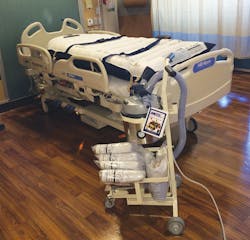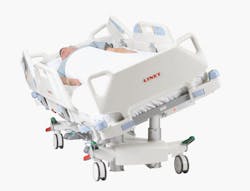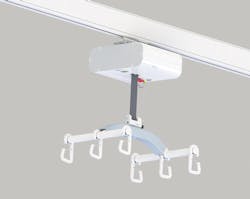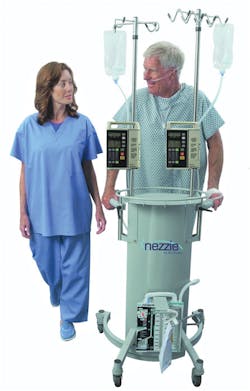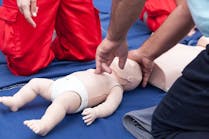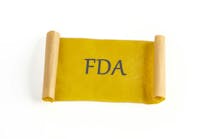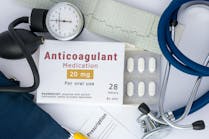Safe patient handling shouldn’t be a pain in the neck
What can you do? That’s just the way it is — it comes with the territory. In healthcare, as in life, we submit to this adage frequently. But when it comes to nurses and back injuries, it’s a mindset that should be consigned to the past.
Hospitals have some of the highest rates of musculoskeletal injuries when compared to other industries. The rate of injury among full-time hospital workers is more than twice the national average — 68 per 10,000 compared to 33 per 10,000, with rates even higher among nursing home caregivers and ambulance workers.1 The single greatest risk factor? Manual patient handling.
Safe patient handling (SPH) expert Michael Maske, founder and president of ZM Medical, has been a strong and vocal advocate over the last decade for widespread implementation of SPH programs. Yet he says calls from the SPH industry are akin to “voices crying in the wilderness.” And while most decision-makers at healthcare facilities say they want to adopt and enforce a strong SPH policy, they also give reasons for why they haven’t.
“’There’s no money in the budget. Staffing levels are low. Nurses don’t have the time to learn new procedures. There are plenty of stretchers in this hospital already. We’ve always done it this way,’” said Maske, author of “Voice of the Nurse,” a book about the many stressors inherent to nursing. “And then there’s the rationale that still permeates the entire organization: Nurses are just going to get hurt. It’s a part of their job.”
Not for long.
Change is in the air
Perhaps the will to find a way will strengthen if congress enacts the Nurse and Health Care Worker Protection Act of 2015, an amendment to title XVIII (Medicare) of the Social Security Act, which would apply to hospitals receiving Medicare funds. The bill has been sitting with the Subcommittee on Workforce Protections since March of last year, but if it passes the Department of Labor would have to establish a standard on safe patient handling, mobility, and injury prevention to prevent musculoskeletal disorders for health care workers, including the adoption of SPH engineering and safety controls.
“Fifty-two percent of nurses complain of chronic back pain and 38 percent suffer from pain severe enough to require leave from work,” wrote the authors of the bill. “Many nurses and other health care workers suffering back injury do not return to work. These consequences constitute a material impairment of health for these employees under the Occupational Safety and Health Act of 1970. The development of assistive patient handling technology, equipment, and devices has essentially rendered the act of strict manual patient handling outdated and typically unnecessary as a function of nursing care.”
Meanwhile OSHA is also getting more involved, claiming it will do a better job focusing on SPH protocols during facility inspections and penalizing those who fall short. “It has sent letters to hospital CEOs stating that it will intervene and inspect to ensure healthcare facilities create a safe working environment, with hospitals incurring a $7,000 fine per incident,” said Maske.
The impact of the Affordable Care Act on patient care, outcomes and satisfaction is also pushing reform. For example, “With the nursing population older than ever and the patient population older and heavier than ever, it has become increasingly difficult for healthcare workers to move bedridden patients as frequently as they should, especially without incurring further damage to fragile skin,” Maske reminded. “Patient falls are another consideration. Forty-seven percent of falls occur during toileting.”
Empowering staff
It’s important to note that some facilities aren’t waiting and did take steps to implement SPH initiatives … only to watch them fail after the expensive equipment was purchased but rarely used. In many cases a lack of education and training of nursing staff leaves them feeling unprepared to operate it properly or that using it is too complicated and time-consuming.
“So, then you have equipment sitting unused in storage rooms, or nurses being intimidated by it and going back to manual lifting because it’s what they know and what they’re comfortable with, and it seems the easiest and most efficient route to mobilizing their patients,” said Jillian Einck, Clinical Marketing Manager at ATLAS Lift Tech, a company that offers safe patient handling & mobility services, program implementation, tracking software, training experts and consulting. “Another issue we have run into is ownership of the program: it affects everyone yet is owned by no one; and so, the individuals who are appointed or volunteered to head the initiative find themselves at an impasse. An engaged and enthusiastic program champion creates the entire tone for the program, and that attitude will trickle down through the units to the nurses on the floor, caring for their patients.
“The ATLAS Lift Coach model takes safe patient handling professionals specially trained in safe patient handling and mobility (SPHM) technology, equipment, resources, and accessories required to position and mobilize patients, and installs them at the bedside to deliver safe patient handling training to the nurses,” Einck continued. “This one-on-one supportive coaching method empowers the nurses to perform their patient handling tasks safely with the appropriate equipment themselves. One facility in Northern California saw a reduction of 88 percent in lost work days; from 2,006 to 251 over a two-year period. Another saw their average annual patient handling injury cost go from $273,900 to $20,700 in just one year, with proper lift equipment usage in 86.9 percent of over 17,000 patient handling tasks.”
Mitchell L. Niedbalec, President, ErgoCare Inc. says getting staff to use purchased equipment can also be achieved more easily if they’re included early on. “The most successful programs start with staff buy-in,” he said. “When staff feel they made the decision, compliance increases.”
A few solutions
To prevent staff from engaging in a manual lift during lateral transfer, ErgoCare offers the ErgoMatt, which operates on air-assisted technology to boost and position patients comfortably and safely. “Air-assisted technology is proven to reduce workplace injuries and associated costs 50 percent to 100 percent when implemented into a safe patient handling program,” Niedbalec said.
This is how it works: “When staff inflate the mattress, air lifts the patient within five seconds. Air escapes through tiny holes on the bottom which act as a lubricant and breaks the friction plane, making it 90 percent easier than a slide board. The patient is then supported on a comfortable bed of air eliminating pressure points and skin shear/tear as the patient is in contact with the ErgoMatt at all times. It also prevents post-op bleeding, dislocations and bruising due to transfers. ErgoCare has been successfully implemented in the VA, University, Naval, Air Force, Scripps, Kaiser, CHW/Dignity, Sutter, Magnet and many other hospitals.”
Jeff Bell, Vice President, National Accounts, LINET Americas Inc. says it’s very common for nurses to injure themselves while repositioning patients up in bed, despite the availability of lifting equipment. “Why? It’s a matter of practicality,” suggested Bell. “Products such as floor-based and ceiling-mounted lifts can be effective in safely moving patients, however, it takes time and multiple caregivers to do it. In today’s healthcare environment and reduced reimbursement, it’s hard for hospitals to staff to that level, so nothing really changes unless technology or process improvement allows hospitals the ability to do more with the same level of staff.
“If the solution doesn’t make life easier, safer, and more efficient for the caregiver, and at the same time improves care for the patient at a reasonable cost, nothing changes,” Bell continued. “The barrier in place for some hospitals is simply the economic reality that the technology chosen at the time of purchase was all there was, and it didn’t meet the change equation above. To put the right solution in place will require another purchase and some aren’t willing or able to make that happen.”
Introduced three years ago, LINET’s Multicare bed with Hercules Patient Repositioner makes it possible for one nurse to safely reposition a patient just by pushing a button. Bell said three hospitals that have used the system over a 12-month period engaged in a comparative analysis that showed an 86 percent reduction in healthcare-acquired pressure ulcer incidences; 75 percent reduction in lost work days; 75 percent reduction in light duty assignments (restricted days); 67 percent reduction in caregiver injuries; and 21 percent improvement in caregiver satisfaction.
For facilities that do want to implement lifts, Jon Winer, President and CEO of Tollos Inc. said they may seem costly at first but when used regularly as part of a comprehensive SPH program, the return on investment can also seem handsome in terms of reduced workers’ compensation, lost work days, and direct medical expenses.
“Health facilities that install and use 50 Tollos ceiling lifts can save, in the first year alone, upwards of $83,333 on direct injury costs, $256,641 in productivity savings, $450,000 in reduction of facility-acquired pressure ulcers, $280,000 in reduction of pneumonia as well as a 70 percent reduction in injuries due to safe handling. Other less tangible benefits include, as one Georgia health system experienced, improved staff recruitment and retention, reduced use of pain meds to transfer patients and overall better patient outcomes and increased satisfaction.”
Winer says Tollos ceiling lifts can accommodate barn doors, booms, and other tricky areas. For example, lifts were installed at a Maryland facility without disturbing the existing fire alarm and sprinkler system and flexible engineering tools now make it possible to place them in CT and patient rooms where low ceilings or other obstructions might otherwise have deemed lifts unsuitable.
“Tollos Cirrus Electric Ceiling Lift also offers an optional integrated patient weigh scale and iQ technology that provides intuitive diagnostics for a smarter lifting program, including supplying data on number of lifts, hours in use, low battery operation, and service alerts.”
Today’s healthcare providers also understand that the sooner patients are up and moving, the more likely they are to experience a quicker, healthier recovery, with fewer complications and reduced length of stay. The key, however, is making sure they ambulate safely.
“They understand that a patient’s mobility level helps determine how soon and how well that individual can move, thereby working muscles, improving balance, and stimulating blood flow — all keys to a rapid recovery,” Maske explained. “At Banner Health, a team has developed the Banner Mobility Assessment Tool (BMAT) to assess a patient’s mobility level. The caregiving team can then determine the appropriate SPH equipment that will be required to assist with getting out of bed, toileting, ambulating, and other daily activities.”
Nick Marinis, Executive Vice President, Blickman, says there is increased interest in implementing comprehensive mobility programs but progress can be slow during the collaborative process when input is required from various stakeholders. “Normally, this is a positive, as it ensures good decisions and best practices,” Marinis said. “The problem is every day of delay leaves the staff vulnerable to injury that much longer. In many cases the problem is with the protocols: they haven’t been written yet, aren’t in place or aren’t being followed. Whatever the protocol, it needs to be set and the staff fully trained.”
When factoring safe mobility into a program, the Nezzie, developed by a thoracic surgeon, can be a useful tool for getting post-operative patients out of bed and moving safely with fewer caregivers than it might typically require.
“Up until now the obstacles to safe, frequent and early ambulation have included a lack of staff needed to handle both the patient and the array of connected medical devices including pumps, monitors, oxygen tanks and drains that must move with the patient,” Marinis explained. “Nezzie enhances safety by providing a stable ambulation device that gives the patient support and confidence. This reduces the likelihood of missteps or falls. Further, since Nezzie is designed to reside bedside and remain with the patient throughout his or her stay, all medical equipment is contained within the device and remains connected.”
Marinis said by implementing the Nezzie, Duke Raleigh projects a decreased length of stay for vented and surgical patients of one day, reduced ventilator-associated pneumonia by four incidents and reduced pressure ulcers and falls by two each — positive outcomes that could yield the facility a projected $1.2 million savings in the first year.
References
http://www.bls.gov/iif/oshwc/osh/case/ostb4374.pdf
https://www.congress.gov/bill/114th-congress/house-bill/4266

Valerie J. Dimond | Managing Editor
Valerie J. Dimond was previously Managing Editor of Healthcare Purchasing News.



